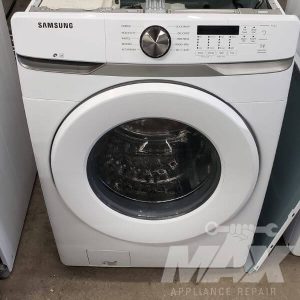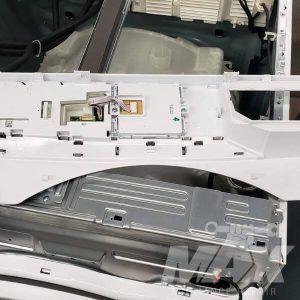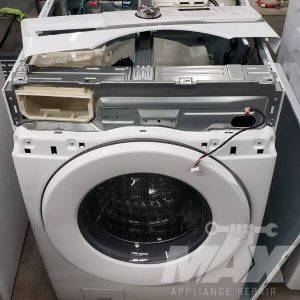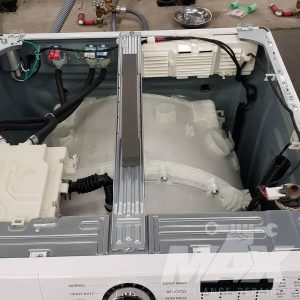
Modern Samsung Washer Control Board Repair
At Max Appliance Repair, we recently received a call from a customer who was experiencing issues with her modern Samsung Washer. The appliance was unresponsive and wouldn’t turn on. After confirming there were no problems with the power supply, we removed the top panel of the washer and inspected the main control board, discovering signs of malfunction. The customer was informed about the need to replace the faulty control board and ordered an authentic replacement part directly from Samsung.
Upon receiving the new control board, we carefully installed it, ensuring proper seating and alignment. We reconnected the wiring harnesses, reattached the top panel, and performed a full diagnostic test on the Samsung Washer. The appliance powered on without any issues, and ran it through a complete wash cycle to confirm all functions were operating as expected.
Our GE Laundry Centre Repair in Action
At Max Appliance Repair, our years of experience and dedication to customer satisfaction ensure that we always provide the best possible service for any appliance issue. Feel free to contact us whenever you need quality dryer repair services contact us or call us today at (647) 477-0946.
Some More Common Issues With Samsung Washers
Samsung modern washers are celebrated for their advanced features and outstanding performance. However, like any electronic appliance, they may experience occasional issues. Below, we delve into five common concerns that may arise with modern Samsung Washers:
Unbalanced Load:
Samsung Washers, like many other washing machines, can experience issues with unbalanced loads. This occurs when the laundry inside the drum is unevenly distributed, causing the washer to vibrate excessively or even halt the cycle. The washer may display an error code (e.g., “dc” or “Ub”) to indicate this issue.
Water Leakage:
Water leakage is another common issue found in Samsung Washers. This can occur due to a damaged or improperly connected hose, a clogged drain pump filter, or a malfunctioning door seal. Identifying the source of the leak is essential for proper troubleshooting and repair.
Faulty Door Lock:
Samsung Washers may experience problems with the door lock mechanism, which can prevent the washer door from closing or opening correctly. A faulty door lock can also cause the washer to not start, as the appliance will not operate if it detects the door is not securely locked.
Suds Buildup:
Excessive suds buildup is a unique issue that can occur in Samsung Washers when too much detergent is used or when using high-efficiency detergent inappropriately. This can lead to poor washing performance and may cause error codes such as “SUD” or “nd” to be displayed. To resolve this issue, users must ensure they are using the correct type and amount of detergent for their specific washer model.
Sensor Malfunctions:
Samsung Washers utilize various sensors to optimize their performance, such as the water level sensor, temperature sensor, and speed sensor. However, these sensors can sometimes malfunction or become dirty, leading to issues with water intake, temperature regulation, or spin speed. In such cases, the washer may display an error code (e.g., “LE,” “tE,” or “3E”) and require professional attention to diagnose and repair the faulty sensor.
Licensed & Experienced
Warranty on Parts & Labour
100% Customer Satisfaction
Award Winning Support
24/7 Emergency Services
Common Error Codes For Modern Samsung Washers
Here are some common error codes found in Samsung Washers Made After The Year 2018.
These error codes indicate a problem with the water supply. They can be triggered by insufficient water pressure, a kinked or blocked water hose, or a malfunctioning water inlet valve. Ensure the water supply is functioning correctly and inspect the hoses and valves for any issues.
These codes point to a problem with the washer’s draining system. They can occur due to a blocked or kinked drain hose, a clogged drain pump filter, or a faulty drain pump. Check the drain hose for any obstructions and clean the drain pump filter to resolve this issue.
These error codes signify an issue with the washer door lock mechanism. The washer will not operate if it detects the door is not securely locked. Inspect the door lock for any damage or debris and ensure that the door is closing properly.
These codes represent an unbalanced load within the washer drum. An uneven distribution of laundry can cause the washer to vibrate excessively or stop the cycle. To resolve this issue, redistribute the laundry inside the drum and restart the cycle.
These error codes are related to the temperature sensor, indicating a malfunction or an abnormal temperature reading. The issue could stem from a faulty temperature sensor, a damaged or loose wire harness, or a problem with the control board. Professional assistance may be needed to diagnose and repair the underlying issue.
Please note that these error codes may slightly vary depending on the specific model of your Samsung Washer. Always consult your user manual for accurate troubleshooting information.
Certified Technicians
Do you need help?
Get a Free Quote
To schedule your appointment or get an estimate give us a call or fill in the form
Toronto & GTA
(647) 477-0946

Frequently Asked Questions About Modern Samsung Washers
First, check that the power cord is securely plugged into the outlet and that the outlet is functional. If the issue persists, there could be a problem with the control board or internal wiring, and professional assistance may be necessary.
This could be due to an unbalanced load, worn suspension components, or a loose drum support. Redistribute the laundry, and if the issue continues, contact a professional repair service.
Inspect the hoses for damage or improper connections and ensure the door seal is intact. If the problem persists, a professional technician can help identify and fix the source of the leak.
Error codes are the washer’s way of indicating a specific issue. Refer to your user manual or search online for the specific error code to understand the problem and troubleshoot accordingly.
It is recommended to clean the drain pump filter every 1-2 months, depending on usage, to prevent blockages and improve drainage efficiency.
Use only high-efficiency (HE) detergents in appropriate amounts for your Samsung Washer. Regular detergents can cause excessive suds and poor washing performance.
Inspect the hoses for wear and tear regularly, and replace them every 3-5 years, or as needed, to prevent leaks and water damage.
